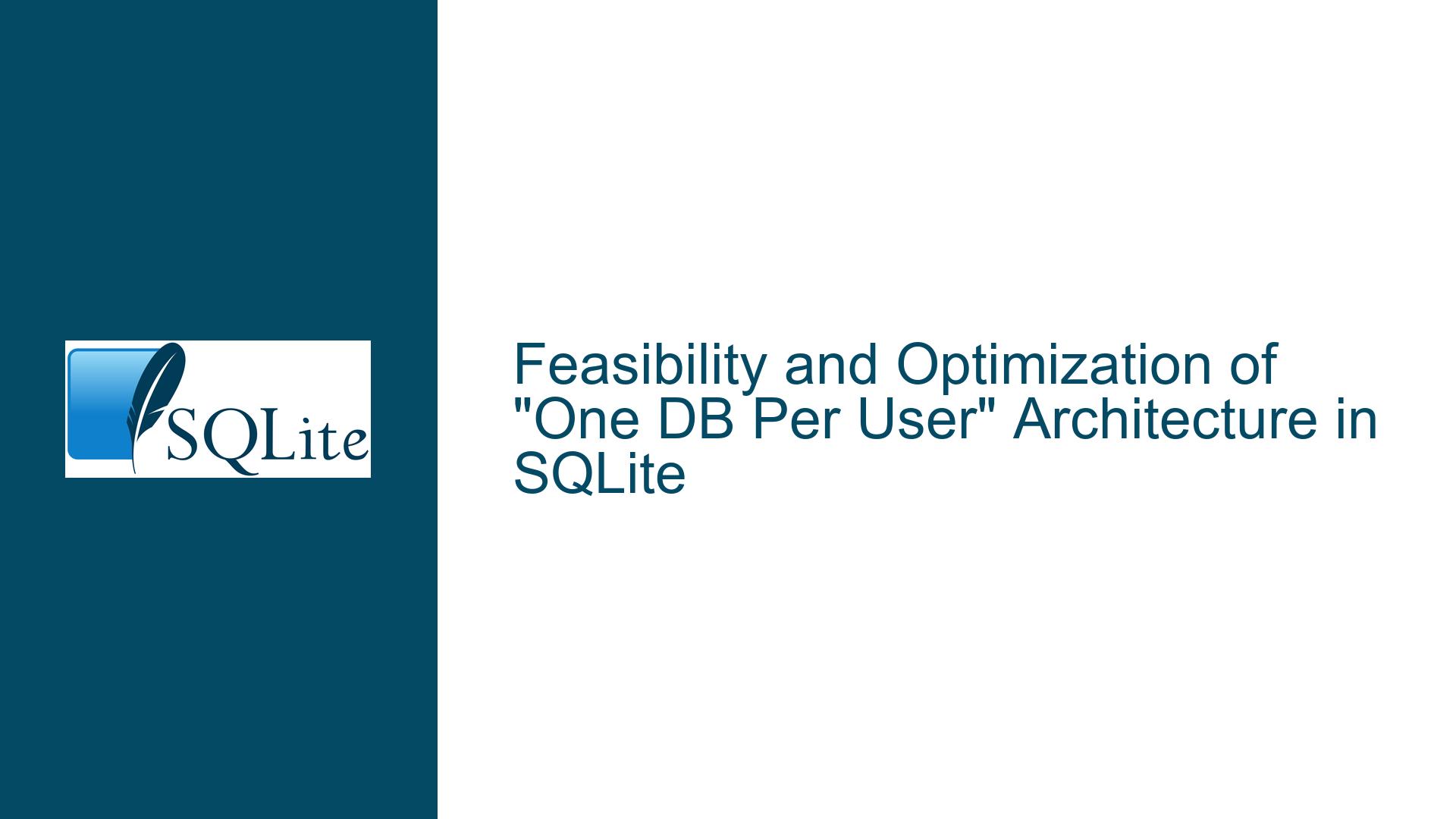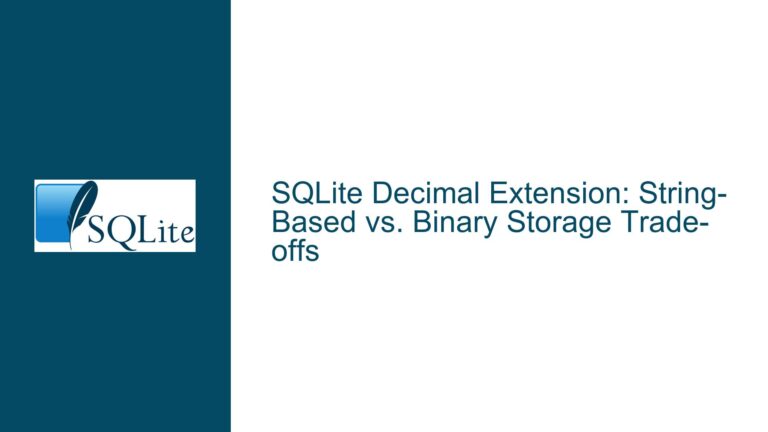Feasibility and Optimization of “One DB Per User” Architecture in SQLite
Issue Overview: Evaluating the "One DB Per User" Architecture and Its Implications
The "one DB per user" architecture is a design pattern where each user in a system is assigned their own SQLite database. This approach is often chosen for its simplicity, security, and scalability benefits. In this architecture, each user has a dedicated database for authentication and session management, as well as separate databases for each application they interact with. Additionally, there is a global database for each application that serves as a read-only repository for shared data. The schema across user-specific and global databases is consistent, and data synchronization between user databases and the global database is managed through periodic updates.
The primary advantage of this architecture is data isolation. By segregating user data into individual databases, the risk of data leakage or unauthorized access is minimized. Furthermore, this design allows for easier data management and backup, as each user’s data is contained within a single file. However, this approach also introduces several challenges, particularly as the system scales. These challenges include increased storage requirements, potential performance bottlenecks during data synchronization, and the complexity of managing a large number of database files.
One of the key concerns with this architecture is the scalability of storage. As the number of users grows, the total storage required for individual databases can become significant. This is especially true if each user’s database contains a large amount of data. Additionally, the process of synchronizing data from user databases to the global database can become a performance bottleneck. The current approach involves deleting and re-inserting data, which may not be efficient for large datasets or high-frequency updates.
Another consideration is the potential use of Datalog as an alternative data model. Datalog is a declarative logic programming language that is often used for querying and managing data. Unlike SQL, which is based on a relational model, Datalog uses a pattern-matching approach for querying data. This can offer advantages in certain scenarios, particularly for rapid prototyping or when dealing with complex data relationships. However, integrating Datalog with SQLite presents its own set of challenges, including the need for custom query translation and potential performance issues.
Possible Causes: Scalability, Performance, and Data Model Challenges
The "one DB per user" architecture introduces several potential issues that can arise as the system scales. These issues are primarily related to scalability, performance, and the choice of data model.
Scalability Concerns: As the number of users increases, the total number of database files also grows. Each user has at least one database for authentication and session management, and potentially multiple databases for different applications. This can lead to a significant increase in storage requirements, particularly if each user’s database contains a large amount of data. Additionally, managing a large number of database files can become complex, especially when it comes to backups, migrations, and updates.
Performance Bottlenecks: The process of synchronizing data from user databases to the global database can become a performance bottleneck. The current approach involves deleting all data associated with a user from the global database and then re-inserting the updated data. While this approach works well for small datasets, it may not be efficient for larger datasets or high-frequency updates. As the amount of data grows, the time required for these operations can increase significantly, leading to slower synchronization times and potential downtime.
Data Model Challenges: The use of Datalog as an alternative data model introduces additional complexity. While Datalog offers advantages in terms of query flexibility and rapid prototyping, it is not natively supported by SQLite. This means that any Datalog queries must be translated into SQL before they can be executed. This translation process can be complex, particularly when dealing with advanced Datalog features such as recursion or negation. Additionally, the performance of Datalog queries may not be optimal when executed on a relational database like SQLite, particularly for large datasets.
Indexing and Query Optimization: Another potential issue is the impact of indexing on query performance. In the current architecture, each user’s database is indexed independently, which can lead to performance issues as the amount of data grows. While indexing can improve query performance, it can also slow down write operations, particularly if the indexes are large or complex. Additionally, the global database may require different indexing strategies to optimize query performance, particularly if it contains a large amount of data from multiple users.
Troubleshooting Steps, Solutions & Fixes: Optimizing the "One DB Per User" Architecture
To address the challenges associated with the "one DB per user" architecture, several optimization strategies can be employed. These strategies focus on improving scalability, performance, and data model integration.
Optimizing Storage and File Management: To mitigate the storage challenges associated with a large number of database files, consider implementing a more efficient file management system. This could involve compressing database files, using a distributed file system, or leveraging cloud storage solutions. Additionally, consider implementing a tiered storage system where older or less frequently accessed data is moved to cheaper, slower storage, while frequently accessed data remains on faster storage.
Improving Data Synchronization Performance: To improve the performance of data synchronization, consider implementing a more efficient synchronization strategy. Instead of deleting and re-inserting all data, consider using a differential synchronization approach where only the changes (inserts, updates, and deletes) are applied to the global database. This can significantly reduce the amount of data that needs to be processed during synchronization, leading to faster synchronization times and reduced downtime. Additionally, consider using batch processing or parallel processing to further improve performance.
Integrating Datalog with SQLite: To integrate Datalog with SQLite, consider implementing a custom query translation layer that converts Datalog queries into SQL. This translation layer can be implemented in the application code, allowing Datalog queries to be executed on the SQLite engine. Additionally, consider using temporary tables to store intermediate results during query execution. This can help simplify the translation process and improve query performance. For more advanced Datalog features, such as recursion or negation, consider using a hybrid approach where some queries are executed in Datalog and others in SQL.
Optimizing Indexing Strategies: To optimize query performance, consider implementing different indexing strategies for user databases and the global database. For user databases, focus on optimizing indexes for the most frequently accessed data. This may involve creating composite indexes or using partial indexes to reduce the size of the index. For the global database, consider using more advanced indexing techniques, such as full-text search or spatial indexing, to optimize query performance for large datasets. Additionally, consider using index tuning tools to identify and optimize poorly performing indexes.
Implementing Data Partitioning: To further improve scalability and performance, consider implementing data partitioning. Data partitioning involves splitting a large database into smaller, more manageable pieces. This can be done based on user ID, application, or another relevant criteria. By partitioning the data, you can reduce the amount of data that needs to be processed during queries and synchronization, leading to improved performance. Additionally, data partitioning can make it easier to manage backups and migrations, as each partition can be handled independently.
Monitoring and Performance Tuning: Finally, implement a robust monitoring and performance tuning strategy to identify and address performance bottlenecks. This can involve using performance monitoring tools to track query execution times, disk I/O, and memory usage. Additionally, consider implementing automated performance tuning scripts that can adjust database settings, indexes, and query plans based on real-time performance data. By continuously monitoring and tuning the system, you can ensure that it remains performant and scalable as the number of users and data grows.
In conclusion, while the "one DB per user" architecture offers several advantages, it also introduces several challenges that must be addressed to ensure scalability and performance. By implementing the optimization strategies outlined above, you can mitigate these challenges and create a robust, scalable, and performant system.






